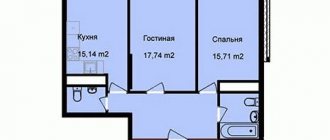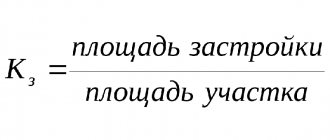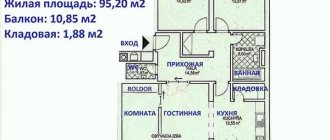How many square meters are allowed per person according to standards?
- When transferring housing to a citizen for temporary use in connection with the conclusion of a social tenancy agreement.
- If there is a need to improve the quality of life of people (providing subsidies).
- In case of appointment of special payments for the purchase of living space or compensation of expenses for payment of housing and communal services.
These are cases of certifying the rights of a social tenant to issue additional squares, when registering temporary residents, when relocating a tenant for the period of major restoration of a building, division of property, eviction of tenants and calculation of the amount for payment of living space.
SanPiN N 42-121-4719-88
3.10. The premises of the medical center, isolation ward, and canteen should be located on the 1st floor. It is advisable to place premises for cultural events, consumer services and administrative ones on the 1st - 2nd floors with maximum isolation from residential premises. Student study rooms should be located separately from rooms that are sources of noise. Rooms for sports activities should be located on the 1st or basement floors. Gyms are located in separate buildings. In the basement floors it is allowed to place common laundry rooms, showers, storage rooms for storing household equipment and dirty linen, rooms for drying clothes and shoes, technical and other utility rooms.
3.7. Living rooms should be impenetrable, with access to the corridor directly or through the hallway. Dormitory rooms of vocational schools and secondary specialized educational institutions must be directly connected to the corridor. Doors to living rooms must open inward and have sealing gaskets in the doorways. The width of living rooms must be at least 2.2 m.
The Russian Ministry of Construction has completed the updating of SP 257 “Hotel buildings. Design Rules" and SP 379 "Dorms and Hostels. Design Rules". The changes were made in accordance with the Decree of the Government of the Russian Federation of November 18, 2021 No. 1860 “On approval of the Regulations on the classification of hotels”, as well as taking into account the wishes of hoteliers, which were consolidated by the public organization “Opora Rossii”.
“The most important change was the inclusion in SP 257 of requirements for hostels as a new type of hotel. Previously, hostels were included in SP 379 “Dorms and hostels. Design Rules". The document excludes the restriction on the minimum occupancy of hotels (from five rooms), because design practice has shown demand for this type of facility,” emphasized Dmitry Volkov, Deputy Minister of Construction and Housing and Communal Services of the Russian Federation.
The updated document includes requirements for the design of landscaping elements, physical education and sports facilities, taking into account the creation of an accessible urban environment for people with limited mobility.
In addition, the set of rules added requirements for the presence of a freight elevator and for increased sound insulation in hotels with more than 50 rooms (four-star categories and above), and determined the minimum recommended room area in a hostel and in seasonal hotels, as well as rooms categories “apartment”, “studio”, “suite”, “luxury”, “junior suite”.
“In order to improve the comfort and quality index of the urban environment, the updated document contains a requirement for hard road surfaces on approaches and entrances. However, in order to better take into account various local conditions, this requirement is excluded for objects located in rural or mountainous areas, as well as in a forest or on the shore of a reservoir. There, the type of road surface is adopted according to the design specifications,” noted Diana Leikina, chief architect of TsNIIPromzdanii JSC.
The set of rules has been supplemented with standards that allow improving the quality of legal regulation of the provision of hotel services and classification of tourism industry facilities. These include calculations of the area of halls, recommendations for the minimum area of a room in a hostel and superior category rooms, clarification of the bathroom area in four-star hotel rooms and the number of shared bathrooms and bathrooms for residents in rooms without a bathroom. This makes it possible to eliminate contradictions that arise during the design and examination of design solutions, and to prevent a significant number of lawsuits on controversial issues, including those of a commercial nature.
“Controversial situations that can lead to litigation include situations where there are discrepancies with other regulatory and legislative documents. For example, a design decision on the layout, set, purpose of premises or the use of terms is made according to one document, and a person using another document can challenge it. At the same time, reworking the project or already erected structures results in significant financial losses. Therefore, during the revision, all provisions of the document were checked for compliance with other regulatory documents and, in particular, Resolution of the Government of the Russian Federation of November 18, 2021 No. 1860 “On approval of the Regulations on the classification of hotels,” emphasized Sergei Muzychenko, director of the FAU “FCS”.
When updating SP 379 “Dorms and hostels. Design Rules" has excluded provisions for hostels due to changes in the legislation of the Russian Federation, and the requirements for calculating the area of residential cells and residential blocks have been updated. Due to significant changes in building operation technologies, the composition and area of public and ancillary premises for common use, technical and administrative premises have been revised. Differentiation of requirements, allowing for flexibility in planning solutions, consists, first of all, in the abandonment of the rigid nomenclature of utility rooms, previously necessary due to the insufficient development of the city's service infrastructure, as well as in the development of options for organizing and combining living rooms, cells and blocks. All this will give greater freedom to the architect and, ultimately, will have a positive impact on the comfort of living.
“Optimizing the requirements for the space-planning structure of dormitories, bringing them into line with modern developments in technology and infrastructure, will have a positive impact on both the efficiency of the design and construction of such buildings and, ultimately, on the quality of the living environment for students and graduate students living in them , workers and employees,” emphasized Dmitry Volkov.
The work to update the sets of rules was organized by the FAU "FCS" and carried out by the team of authors of JSC "TsNIIPromzdanii" with the active participation of the public organization "Support of Russia".
Determination of living space in a dormitory
Hello. According to Article 105 of the Housing Code, a minimum of 6 sq.m. must be provided for each student in the dormitory. living space. The area of our room is 14 meters, that is, 2 people should live in it. Can the administration of the hostel add to these 14 meters the area of the corridor, bathroom and toilet in order to accommodate a third person? Thank you in advance
In accordance with Part 2 of Article 15 of the Housing Code of the Russian Federation, residential premises are recognized as isolated premises, which are real estate and are suitable for permanent residence of citizens (meets established sanitary and technical rules and regulations, and other legal requirements).
Heating fees in dormitories: are common areas subject to payment?
Serega
writes 12/13/2021: I was suing the management company regarding the debt, and even though the judge wrote that there was no competition for selection, management comp. was not elected, there is no meeting of owners, but the services are actually provided by the plaintiff. management of organizational municipal unitary enterprise of housing and communal services. but I stopped paying because they charge 26.05 for common areas, and the privatized room is 17.6. I looked at the decisions via the links on your website, argued in court, and the court made a decision on the basis of Article 15.5, even though I talked about Part 2 of the same article. We have a miracle town and our own laws, the world court simply cuts it down without really considering it, the federal one changes it but there’s no point, and the supervision in Novosib suits everything the same, so I’m getting ready to complain to the Supreme Court, but there’s little hope. And you The lawyer is very strong, I looked on the forum, everything is as clear as in a pharmacy, a man is sitting and enlightening people, but my hope is fading. There is no law in our country. Thanks in advance. in the hostel, only we have a common kitchen in the hallway, and between 4-4 rooms there is a toilet, a washbasin, and there used to be showers, now there are storage rooms. The management company has provided agreements with resource supply organizations, and 80% of the rooms belong to the administration. but I wanted to pay only for the living space, and all expenses with the actual living space 17.6. And the management company considers all services from the common plus a corridor, a common kitchen and a washbasin with a toilet
We recommend reading: Up to what age can you buy a train ticket at children's ticket offices?
In the above court decision, the court recognized that fees should be calculated based on the total area of the premises owned by the owners. I think this is the right decision. It complies with both the Housing Code of the Russian Federation and Resolution No. 307. In that case, the management company charged residents for common areas that did not belong to the residents’ apartment. The court found this to be incorrect. You need to insist on the same in your case.
What is the standard living area per person in a dormitory and what regulations regulate this?
I work on a rotational basis in the Far North. Accommodation is organized in a dormitory. Currently, the area per resident is approximately 6.5 - 7 square meters. m. The administration has begun to double the number of residents in the rooms. When implementing these actions, the area per resident will be 3 - 3.5 square meters. m.
We recommend reading: Time limits for entering into an inheritance without a will
When moving into a dormitory, the standard for providing living quarters for each person must be met. The provision norm is established by the normative legal act of the municipality on whose territory the specialized residential premises (dormitory) are located.
How is the living area of an apartment calculated?
We found out what the total living area of the apartment includes. SNIP (1-71 “Residential buildings” dated January 31, 2021) indicates that, as already mentioned, all residential and non-residential premises are classified as common space (not residential).
We recommend reading: How to pay contributions to the Pension Fund in Sberbank online in your personal account
In accordance with Art. 16 Housing Code of the Russian Federation, an apartment is one of the types of residential premises. In order for a room to meet the requirements for an apartment, it must have the following characteristics:
What is the standard square meters per person?
The social norm of area is understood as the minimum that should fall on one person. In the Housing Code of the RSFSR, which was in force before the RF Housing Code came into force, this norm was established by Art. 38 and amounted to 12 square meters. m of living space per person. Moreover, links to Art. 38 in relation to the standard for square meters are still roaming the Internet, although in the current Housing Code of the Russian Federation, in force since 2005, an article with this number describes the right of the apartment owner to a share in the common property (common building infrastructure).
Compared to Soviet times, the modern size of this norm has been slightly reduced (from 12 to 9-10 sq. m of living space per person in different cities), however, it should be taken into account that the total number of state and municipal housing has decreased many times in recent years and most of those under construction Now residential buildings are initially private. In addition, now a citizen can independently improve their living conditions by purchasing or taking out a mortgage on a new apartment.
How many square meters of living space are allowed per person?
- If necessary, confirm the tenant’s right to receive additional space.
- When temporary residents move in.
- Relocation of the tenant during major renovations in the building.
- The real estate property is being divided.
- The tenant is being evicted.
- You need to pay rent for living space.
In each region, this norm has a certain size , which is determined individually. The accounting norm can be changed for specific groups of citizens, including military personnel and disabled people. But a decrease or increase in the accounting rate occurs only on the basis of a Federal Act. Important documents for this are the laws of the subjects themselves, or decrees of the President of the Russian Federation.
What living space standards are used in 2019
- Calculation of monthly payments for living space (calculation of utilities);
- For the settlement of temporary residents (renting out housing);
- The property is divided between the owners;
- Eviction of the tenant;
- Confirmation by the tenant of the right to receive additional living space.
Legislative bodies may review the grounds on which a person can be placed in a flexible fund. If the apartment was taken away for debts, government authorities may provide the debtor with a temporary place of residence to pay off the debt.
Registration norm of living space per person
How much is the standard living space per person? It is important for every citizen to know this information, since otherwise it will not be possible to resolve the issue regarding the division of living space, determining the order of resettlement, resolving a conflict situation regarding the division of an object, etc.
- The minimum standard is established for living space located in dormitories or foundations owned by municipal authorities.
- The provision rate is the smallest amount of space required for living. The allocation of such a minimum is allowed if a social rental agreement is signed with a citizen.
- An accounting norm is the square footage on the basis of which certain authorities calculate whether a citizen or family needs to be allocated additional square meters for living. In accordance with the law, this norm cannot be less than the provision norm.
We recommend reading: Tax on gift for an apartment
Article 128
6. The procedure for providing living space in dormitories is determined by the Regulations on student dormitories, developed in a higher educational institution on the basis of the Model Regulations on student dormitories of a higher educational institution in agreement with student government bodies and the primary trade union organization of students.
We recommend reading: How to correctly write a renunciation letter
Living space in the dormitory is provided in an amount of at least 6 square meters. meters per person. Since the Model Regulations on Dormitories do not establish an upper limit on the size of the living area, the dormitory management limits the living area to 6 square meters. meters is illegal. The norm of living space per person provided for in Article 47 of the Housing Code of the RSFSR does not apply to the living space of hostels.
What living space standards exist: nuances and requirements for establishing
Currently, almost a third of our country's electorate has no chance of improving their living conditions. Therefore, during labor relations, studies in educational institutions or service, the population lives in dormitories with the conclusion of a rental agreement.
Citizens living in houses recognized as unsafe or dilapidated are subject to resettlement. At the same time, one cannot count on improvement in living conditions. For persons living under a social tenancy agreement in a dilapidated building, municipal structures, according to the law, must provide them with housing no worse than before.
Standard living space according to hostel standards
Hello: A social tenancy agreement for residential premises is concluded in writing on the basis of a decision to provide residential premises for social use housing. For dormitories, houses or parts of houses that are specially built or converted for these purposes are provided. The norm for the provision of residential space under a social tenancy agreement (hereinafter referred to as the norm) provision) is the minimum size of the area of residential premises, on the basis of which the size of the total area of residential premises provided under a social tenancy agreement is determined.
2. The provision rate is established by the local government depending on the level of provision of residential premises provided under social tenancy agreements achieved in the relevant municipality and other factors. ARTICLE 50 of the Housing Code of the Russian Federation. Thank you
What is the standard living space per person?
- Provision rate . It is used in the case of transfer of housing under a social lease agreement, including from the municipality’s maneuver fund, in certain cases (in the absence of housing in the event of a natural disaster, in the event of an inability to repay mortgage debts, etc.).
- Accounting norm . It matters when square meters are calculated to improve living conditions.
- Social norm . This value is used when allocating subsidies for housing, as well as subsidizing fees for housing and communal services.
The accounting standard is considered to be the minimum living space that is accepted to recognize a family as in need of improved housing conditions. Citizens whose premises are less than this value have the right to take the appropriate queue. This applies only to those citizens or families who are recognized as low-income.
How many square meters are allowed per person - living space standards
Hello ! I live in the city of Sevastopol, in a dilapidated house (communal apartment). There are 3 of us, my mother is a pensioner, me and my minor son (half-orphan). We occupy 2 rooms of living space (1 room 9 m2) (2 rooms 14 m2). In Sevastopol, there is a program of relocation from emergency housing to new ones. But the authorities are offering very small 1-room apartments of 12-15 m2. Please tell me, according to the law of the Russian Federation, they don’t have the right to give less than what we have? And how much in our case is sq. m per person? Thank you in advance
In accordance with Article 38 of the Housing Code of the Russian Federation, the standard living space is 12 square meters per person. This indicator has different meanings depending on the purposes of its use and the region. It is known that subjects of the Russian Federation in some cases have the right to establish their own standards.
Standards for cleaning premises per one cleaner (office and industrial premises)
- Dry and wet cleaning of floors.
- Removing debris from the work area.
- Cleaning boxes, bags and other types of containers.
- Replacing detergent.
- Wet and dry cleaning of panels, window sills, heating radiators and walls.
- Distribution of litter and removal of it to a specially designated place.
- Cleaning sinks, taps and toilets with showers.
- Washing powder – 1 kilogram.
- Toilet soap – 200 grams.
- Laundry soap – 400 grams.
- Broom – 2 units for 30 days.
- Brushes – 1 unit for 60 days.
- Scoops – 1 unit for six months.
- Rubber gloves – 1 unit for 30 days.
We recommend reading: Does the management company have the right to charge for sewerage per day?
How many square meters are allowed per person in a student dormitory?
There are quite a lot of calculations according to which it is possible to determine the number of square meters allocated per person in our state. Calculations depend on several factors - this includes housing conditions in a particular region and what specific standard should be calculated (sanitary, social, accounting).
Based on the capacity of the dormitories (persons) Standard area per 1 person, m2 Administration and staff premises Premises for cultural events, recreation, educational and sports activities Catering premises Buffet - in dormitories from 200 to 600 people. Cafe - in dormitories for 600 - 1000 people.










